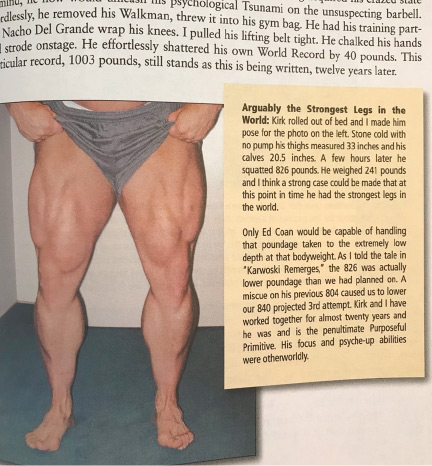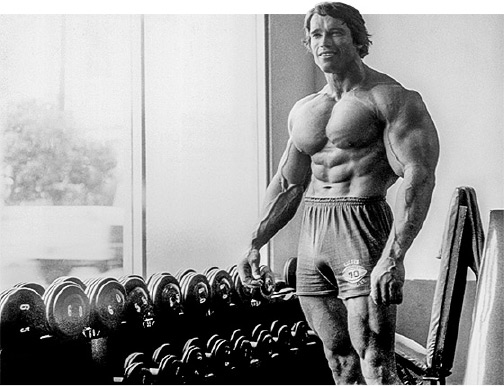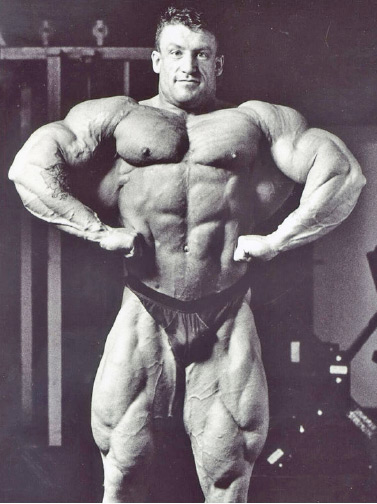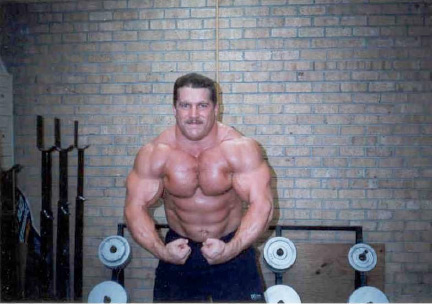
Power Training Minimized
Get the most-est from the least-est
Featured Powerbuilding Equipment: dumbbells, barbells, exercise machines, barbell, free weights, treadmill, exercise bike
Confederate cavalry general Nathan Bedford Forrest revolutionized warfare and he did it on horseback. His tactics and strategies were so profound and revolutionary that to this day they are studied at war colleges all around the world. He was a huge influence on the strategic thinking of tank commanders George Patton and Erwin Rommel. These WWII tank titans simply substituted Panzer Tiger tanks and Sherman tanks for riders on horseback and expropriated Forrest's blitzkrieg-like tactics. One of Forrest's most famous quotes was given when asked by a Prussian general to expound on his central core commandment, to which Forrest replied, "Git thar furst-est with the most-est."
Hardcore power trainers expropriate and reinterpret Forrest's dictum; they modify it into: get the most-est from the least-est. The most-est refers to the most in tangible, measurable, irrefutable results derived from progressive resistance training: muscle, power and strength. The least-est refers to smallest possible (training) time investment.
In a perfect progressive resistance universe, one wherein all results from all systems would be equal - why not select the system that requires the least amount of training time to complete?
Again, if all results are equal, I opt for system that best exemplifies Occam's razor, i.e. "When presented with two systems producing equal outcomes, choose to use the one with fewer moving parts."

Arnold Schwarzenegger Seven Time Mr. Olympia | Competition Weight 235 lbs. @ 6' 2"
That you can obtain dramatic results from a bodybuilding-style high volume, moderate intensity weight training approach is beyond dispute: look at the phenomenal physiques of Arnold, Franco, Sergio and all the other incredible bodies built in the 1960s and early 70s using the ultra-high volume approach. Thousands and thousands of sets with dumbbells, barbells and exercise machines forged those physiques.
That you can obtain dramatic results from a power-style low volume, high intensity training approach is beyond dispute: look at the phenomenal physiques of Dorian Yates, Kirk Karwoski, John Gamble, Jim Cash and all the other power-bodybuilders and powerlifting superstars of the 1980s and 90s.
I choose to hang with with low volume/high intensity crowd because I want to get the most for the least: I have other things to do. I have a life. I have no desire to emulate the training template of a 1970s bodybuilder who typically would weight train six days a week, in long individual sessions. Elite exponents of volume training routinely perform 600 to 700 sets each week: that is one hell of a lot of sets and a huge time commitment.

Dorian Yates Six Time Mr. Olympia | Competition Weight 265 lbs. @ 5' 10"
In stark contrast power bodybuilder Dorian Yates built his rhino body performing less than 100 sets per week, done in four compact training sessions. Kirk Karwoski built thighs and calves to rival Tom Platz. Kirk won six straight IPF world titles (in two weight classes) captured seven straight national titles and set world squat records of 914 in the 242 pound class and 1,002 in the 275 pound class. He built his silverback gorilla body and world record strength performing a mere 50 sets per week. He built his legs using barbell squats alone. His squat workout from start to finish would range between 9-12 sets per week.
The high-volume approach could be equated to flogging a muscle to death with free weights; the classic 70s bodybuilders would routinely perform four exercises per body part, 5-6 sets allotted to each exercise and four body parts were done in each training session. Each muscle was trained THREE times a week. Pros would weight train twice a day, six days a week, twelve times a week, hacking their way through the 600 - 700 sets required for that week…
And to think they didn't do cardio back then - could you imagine if they'd had to incorporate a treadmill or exercise bike into this already gargantuan template? The pro could just sleep on a cot in the gym, awake from naps, train, eat, go back to sleep and never vary and never leave the premises.
By contrast the intensity-biased trainer "shoots the muscle through the heart, killing it instantly" to quote Dorian. The intensity-trainer decimates the muscle to such a degree in a single, all-out set that further all out sets would be pointless. The reps and/or poundage on subsequent sets would plummet to an unacceptable degree - what is the point of handling 55% of what you handled on the big set? All this does is retard recovery.

Kirk Karwoski @ 5' 7" 275 lbs. | World Record 1,003 lb. Barbell Squat
Kirk Karwoski, intensity King, would train three to four times per week and would perform a grand total of 50-60 sets per week. He built world record squat power by squatting once a week, working up to a lone top set of barbell squats. This was done every Monday…one monster top set, done after adequate warmup sets - and he was done for the week. No other leg exercises were done of any kind. How incredible and illustrative that with this little amount of training he set world records that stand to this day. To Kirk's way of thinking, it is not how much you do, rather how hard you do it.
To elicit maximum results from a minimum time investment requires the power trainee extreme physical effort…Herculean effort, teeth-clenching, eye-ball popping, pants-splitting effort…pure physicality…interspersed and punctuated with curses, grunts and groans - yours. This sounds scary and horrible and in fact it is. Effort is the key and this is the brutal and unvarnished truth of transformational fitness. Dramatic results only occur in direct response to Herculean effort. How could it be otherwise?
Do we really think the body will radically reconfigure and transform itself to some dramatic degree in response to submaximal training? Where is the physiological incentive in that?!
How does one define intensity? How are you able to determine with certitude when you have successfully crossed the intensity threshold? How can you know for certain that you've trained hard enough and intensely enough to ignite hypertrophy?
In every training session and in every important exercise, intensity-biased trainers seek to generate some expression of 100% effort - or better yet 102% effort. How is 100% effort defined? Here is the classic iron rule of thumb: when you can barely complete a rep and cannot complete another rep, you have worked to 100% of capacity. You do not need to actually fail with a rep to know you are incapable performing it and should not attempt that rep.
Capacity can vary 2-5% within the same training week. Capacity is always a shifting target. What might be 100% on Monday might be 97% by Friday, due to illness, circumstance or distraction - whatever.
Rep the weights until you can rep no more; leave nothing on the table - give it 100%. Then move on. Maximum 100% efforts unleash a (highly beneficial) floodtide of hormones: adrenaline, endorphins, growth hormone and cortisol. This hormonal release signifies a benchmark, a precursor to hypertrophy, if you do not train intensely enough to unleash the hormonal floodtide there will be no hypertrophy. Intense workouts create a psychological afterglow that is directly attributable to the massive release of the narcotic-like endorphins.
Work up to 100% of capacity in the important exercises. Regardless if capacity on that day in that session is diminished or enhanced, seek to "rep out" on top sets. Rep until you can rep no more. Do so and you have assuredly generated 100%. On those days where you are able to squeeze out an extra rep or two, or add poundage, you can be said to have worked to 102% or 105% of capacity.
Hypertrophy and strength and power gains are obtainable even when capacity is diminished. The volume-biased progressive resistance approach essentially flogs the muscle to death in order to trigger the adaptive response. The hardcore power essentially shoots a muscle through the heart with a sawed-off shotgun, both barrels at the same time and at close range.
Occam's razor postulates that when presented with competing theories (equal in all respects) choose the one with fewer moving parts. There can be no doubt that when presented with the 600-set approach versus the 60-set approach, Occam would select the later. Less can be more if less is maximally intense. And now you know how to qualify and quantify progressive resistance intensity. The lip of the limits is where the gains reside.
About the Author
As an athlete Marty Gallagher is a national and world champion in Olympic lifting and powerlifting. He was a world champion team coach in 1991 and coached Black's Gym to five national team titles. He's also coached some of the strongest men on the planet including Kirk Karwoski when he completed his world record 1,003 lb. squat. Today he teaches the US Secret Service and Tier 1 Spec Ops on how to maximize their strength in minimal time. As a writer since 1978 he’s written for Powerlifting USA, Milo, Flex Magazine, Muscle & Fitness, Prime Fitness, Washington Post, Dragon Door and now IRON COMPANY. He’s also the author of numerous books including Purposeful Primitive, Strong Medicine, Ed Coan’s book “Coan, The Man, the Myth, the Method" and numerous others. Read the Marty Gallagher biography here.

